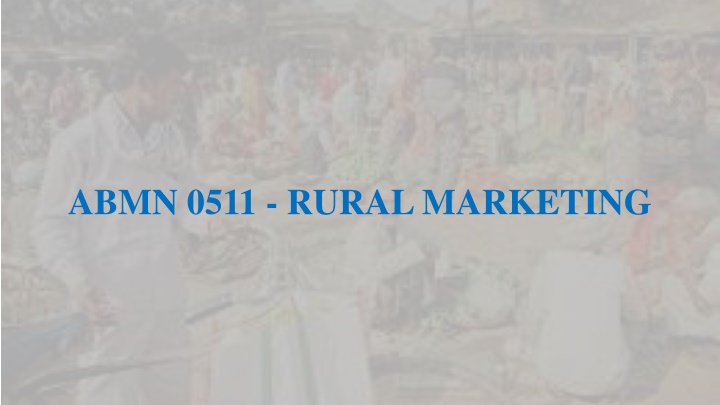ABMN 0511 - RURAL MARKETING
Rural marketing in India involves the flow of goods and services from producers to rural consumers, encompassing demand estimation, product planning, distribution, and ensuring consumer satisfaction. Key components of rural markets include the presence of goods for transactions, buyers and sellers, business relationships, and demarcated areas. The rural market consists of consumer goods and agricultural inputs, with features like a large and scattered population, rising purchasing power, steady market growth, and evolving consumption patterns. Infrastructure development plays a crucial role in enhancing rural marketing opportunities.
Download Presentation

Please find below an Image/Link to download the presentation.
The content on the website is provided AS IS for your information and personal use only. It may not be sold, licensed, or shared on other websites without obtaining consent from the author.If you encounter any issues during the download, it is possible that the publisher has removed the file from their server.
You are allowed to download the files provided on this website for personal or commercial use, subject to the condition that they are used lawfully. All files are the property of their respective owners.
The content on the website is provided AS IS for your information and personal use only. It may not be sold, licensed, or shared on other websites without obtaining consent from the author.
E N D
Presentation Transcript
RURAL MARKET Rural market includes all business activities which involved in flow of goods and services from producers to rural consumers. Rural market covers all marketing activities ascertain the demand, product planning, distribution and facilitating the entire marketing process, with aim of satisfaction of rural consumer.
Components of rural markets For the market to exist, certain conditions must be satisfied. These conditions should be both necessary and sufficient. They may also be termed as the components of a market. 1. Existence of a good / commodity for transactions (physical existence is, however, not necessary) 2. Existence of buyers and sellers 3. Business relationship or intercourse between buyers and sellers; and 4. Demarcation of area such as place, region, country or the whole world. The existence of perfect completion or a uniform price is not necessary.
According to 2011 census of India Population - 5000 density - 400 sq. km. According to NABARD irrespective of villages, Population up to 10,000 The rural market is made up of two broad components: The market for consumer goods which includes both durable and non-durable goods, and The market for agricultural inputs (fertilizers, pesticides, seeds, etc.) and other investment goods.
Features of Rural Markets Population is large and scattered In India around 65 percent of population lives in rural areas. Rate of increase in population is also higher. This large population is scattered in over six lakh villages. Although it poses some difficulty to the marketers but also gives them a huge and promising market. Rising purchasing power Gone are the days when income level of rural people was low. With the green revolution and opening up of the economy after 1990, India has seen an overall growth. This has raised the income level of rural consumers as well.
Steady market growth Rural market is growing steadily over the years. Consumption pattern and preference is also changing. Unlike the past years, rural market has demand for branded products along with the traditional products such as bicycles, mopeds and agricultural inputs. IT and media has further increased the awareness amongst the rural consumers and there is a surge in demand of cosmetics, FMCGs, consumer durables etc. over the year.
Development of infrastructure facilities Infrastructure facilities have developed in the rural areas. This has reduced the distance of villages to the cities. With the construction of roads and transportation, communication network, rural electrification and several public service projects run by the government, connectivity of villages to cities has increased. This has increased the scope of rural marketing.
Low standard of living Although many developments are taking place in rural areas in India, still the fact remains that the standard of living in villages is relatively lower for people who comes under the second and third groups of consumers. People who have sizeable land holdings but they are not very rich farmers (second group) and the people who are daily laborers (third group) who mostly demand the goods and services which are necessities, in small quantities more frequently.
Traditional outlook Rural consumers value their old values, culture, customs and tradition. This influences their demand pattern. However, their demand pattern is changing gradually and demand for cosmetics and branded goods are gradually seeping in the rural markets. Separate marketing mix is required Considering the features of the rural market, it becomes essential for the companies to prepare a separate marketing mix for the rural markets to tap its potential to the fullest.
Importance of Rural Markets India is one of the largest markets in the world. The real India lives in villages. Due to various reasons such as globalization, economic liberalization, IT revolution and improving infrastructure; rural India has been emerging as significant attraction for the marketers. The future of companies greatly depends upon understanding the dynamics of the rural markets.
The increasing focus on farm sector has been boosting the income level of rural consumers. This provides enormous opportunities to the marketers. Infrastructure facilities are becoming better which in turn will help in improving the supply chain operations. The consumption pattern of rural consumers is also witnessing a change.
Factors affecting Growth of Rural Market a) Increased demand due to increase in population b)Agriculture sector is prospering which has risen the rural income c) Increased Standard of living d) Government and non-government organizations are taking keen interest in rural development e) Increased literacy rate and educational level f) Inflow of foreign remittances and foreign made goods into rural areas g) Improved Rural Infrastructure h) Increasing awareness of rural consumers about new products and i) Growing urban-rural interaction.
Classification of rural markets A) Consumer Market Constituents: Individuals and Households Products: Consumables, Food- Products, Toiletries, Cosmetics, Textiles and Garments, Footwear Etc. Durables: Watches, Bicycles, Radio, T.V, Kitchen Appliances Furniture, Sewing Machines, Two Wheeler Etc.
B) Industrial Market Constituents: Agricultural and Allied Activities, Poultry Farming, Fishing, Animal Husbandry, Cottage Industries, Health Centre, School, Co-operatives, Panchayat Office Etc. Products: Consumables, Seeds, Fertilizers, Pesticides, Animal Feed, Fishnets, Medicines, Petrol Diesel Etc. Durables: Tillers, Tractors, Pump Sets, Generators, Harvesters, Boat Etc.
C) Services Market Constituents: Individuals, Households, offices and Production firms. Services: Repairs, Transport, Banking credit, Insurance, Healthcare, Education, communications, Power etc.























